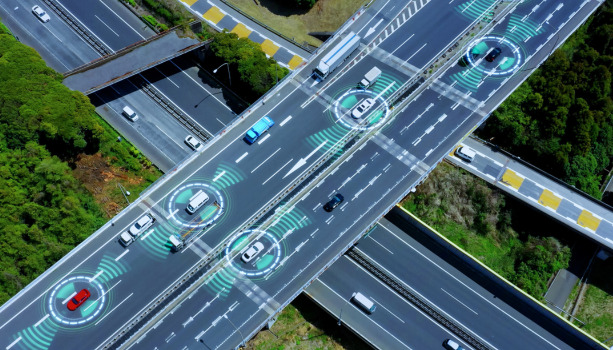Mobility is one of the most vibrant industries today with tremendous room for technological and market growth. As we get accustomed to having smart devices and internet connectivity on hand wherever we go, it becomes inevitable to integrate computing power and connectivity into the automotive and mobility environment.
The focus of the mobility industry is to make the experience of road users enjoyable and the mobility ecosystem efficient and sustainable. To achieve these goals, businesses across diverse fields have been pouring investments and resources into the industry, including automotive, transportation, electronics, energy, ICT, semiconductors, computing, and software. By now, there is no doubt that the next innovation boom will encompass the automotive and mobility industry.
What are the key technologies driving this innovation boom? By examining every aspect of the mobility ecosystem, we observed six trending deep technologies that will rule our roads in the coming years.
Trend 1: Artificial Intelligence
Artificial intelligence (AI) is a crucial technology that drives a wide range of mobility innovations, especially autonomous driving. First, there are the ADAS (Advanced Driver-Assistance Systems), which many refer to as Autopilot. Even though we often say that ADAS are based on cameras and sensors, the underlying computations are powered by AI. The cameras only capture the imagery, while the built-in AI identifies the captured objects based on their shapes and movement patterns, then instructs the vehicle to react appropriately using intelligent modeling.
Next, there is V2X (vehicle-to-everything) communication, which serves as the bridge towards Vehicle-Infrastructure Cooperated Autonomous Driving (VICAD), a set of necessary features for higher levels of driving automation. V2X is a wireless communication technology that enables vehicles to transmit messages in real-time with other vehicles (V2V), road infrastructure (V2I), and pedestrians (V2P). Again, these messages are read and processed by AI, allowing every road user to respond and cooperate in real-time.
Besides AI’s role in autonomous driving, it is used to enhance the user experience for a wide range of mobility services, including carsharing, ridesharing, and ride-hailing platforms, where algorithms help match demand and supply at the right time and location.
Trend 2: Big Data
If data is the new oil, then the mobility ecosystem is the oil reserve. At any given moment, data are generated by hundreds of millions of vehicles and mobility services around the world. These include panel data with information on vehicle condition, driving behavior, location, traffic load, service usage, and many more. Moreover, the number of connected vehicles in use worldwide is forecasted to reach 120 million in 2025 and 700 million by 2030. These connected vehicles will contribute to a tremendous volume of big data that will be used for two main purposes: automation and optimization.
Big data is the fuel that powers AI and autonomous driving. Even though it is quite easy for an autonomous vehicle to learn how to drive by the rules, on the road, there are countless situations where rules are broken by unusual situations and environments. To ensure that vehicles can respond to every unusual situation safely, a massive quantity of data must be fed into the machine learning process. Researchers at the University of Michigan claimed in their research that 17.7 billion kilometers of autonomous driving data must be collected to prove that driverless vehicles can operate safely at an 80% confidence interval. To put it in perspective, this is 118 times the distance from the Earth to the Sun.
Another use of big data is product and service optimization. Many automotive OEMs, including the BMW Group, collect vehicle data from their vehicle fleets under their customers’ consent. This allows them to improve vehicle quality and maintenance services, as well as to make feature enhancements based on the customers’ behavioral feedback. For instance, by tracking mileage and usage data, customers will be notified whenever periodic maintenance is needed. Also, by analyzing data on the number of times a feature is activated, the OEM can prioritize enhancing certain features and phase out some unused features. In the case of BMW, the company also shares its fleet data with other businesses in the European Economic Area (EEA) who wish to use the data for innovative business models, such as pay-as-you-drive insurance policies. Other service providers like Mobility-as-a-Service (MaaS) operators can learn from the usage data generated from their platforms to establish more efficient and responsive ride services.
Trend 3: Next-Generation Communication
As mentioned earlier, the wireless connections used for autonomous driving are generally referred to as V2X, which forms the vehicular ad-hoc network (VANET), a mobile network that facilitates both direct and indirect transmission of messages. V2X can be facilitated by several different communication protocols, utilizing Wi-Fi, LTE, and 5G standards. The Wi-Fi-based protocol was established by the Institute of Electrical and Electronics Engineers (IEEE) and first introduced in its IEEE 802.11p release, widely referred to as DSRC (dedicated short-range communication) or WAVE (wireless access in vehicular environments), allowing vehicles to communicate directly with other OBUs and RSUs on the road using Wi-Fi technology.
The LTE and 5G-based protocols were developed by the 3GPP, collectively known as C-V2X (cellular V2X). This can be further broken down into direct C-V2X, which utilizes the PC5 interface; and indirect C-V2X, utilizing the Uu interface. Like WAVE, The PC5 interface allows road users to communicate directly with other vehicles and infrastructure nearby using embedded LTE and 5G connectivity. On the other hand, the Uu interface connects road users to the cellular network, allowing all participants to connect indirectly with the Internet as a medium. Such indirect C-V2X is sometimes called V2N (vehicle-to-network).
Whereas 3G and 4G LTE standards were developed primarily for smartphones and mobile communications, next-generation communication standards like 5G and 6G emphasize serving the needs of IoT and vehicular communications. Therefore, we will continue to see faster and more reliable ICT technologies in the future, driving innovations for a seamless and safe mobility experience.
Trend 4: Embedded Hardware/Software
The E/E (electrical/electronic) architecture of vehicles is undergoing continuous experimentations and improvements. Traditionally, the computing power of a typical vehicle is entirely contributed by microcontrollers called electronic control units (ECU) – typically up to 100 of them – each of which serves a particular function; some control the mechanical components while others control the infotainment system. However, the computing power of these ECUs is becoming increasingly insufficient for the new software-defined computer-like vehicles. Consequently, OEMs are introducing more creative ways of arranging the in-vehicle system by adopting a more centralized architecture. Many are experimenting with embedding one or two CPUs into the system so that dozens of functions can be controlled by one central computer. These changes have pushed the need for more chipsets and software modules with greater computing capability and functionality. Even though automotive chips and components were once considered an unattractive business for many semiconductor firms due to small purchase quantities and low profit margins, this growing need for more sophisticated components is driving more chipmakers and software suppliers into the mobility game.
Trend 5: Next-Generation Powertrain
Electrification is revolutionizing the vehicle powertrain. Everyone knows that electric vehicles (EV) generate less carbon emission than ICE vehicles, but how do the two different powertrains compare in terms of performance? Perhaps the two major differences are engine efficiency and energy storage. Looking at ICE powertrains first, Internal combustion engines are surprisingly inefficient, in which when they burn fuel and transform it into power, a lot of extra energy is wasted in the form of heat. Nonetheless, the upside is that gasoline is very easy to store. On the other hand, electric motors are much more efficient, transforming most of the energy into power with very little heat waste. Yet, it is much more difficult to conserve energy within the battery, especially in freezing temperatures. Ironically, since electric motors are so efficient that very little heat is generated, it becomes a problem in the winter as all the heat must be transmitted to the battery to maintain adequate performance, leaving no leftover heat for the cabin (meaning that additional electricity is consumed to power the heater).
Therefore, current research and developments in the automotive industry are focusing on battery technology, especially on ways to conserve energy and keep unnecessary drainage to a minimum. Energy firms are dedicated to increasing battery efficiency and reducing carbon emissions in the battery production process, while OEMs are working on making powertrain improvements for more optimized energy distribution within the vehicle.
Another related industry is the EV charging industry. Currently, the charging process can be quite complicated as users need to download apps for each charging provider and register as a member. Plug&Charge (PnC) technology is developed so that the entire charging process becomes standardized and automated. The user only needs to plug in their charger and payment will be made to the respective charging provider automatically.
Trend 6: Security
As the mobility ecosystem becomes increasingly interconnected with data sharing occurring in real-time, cybersecurity must be implemented wherever data exist to keep them safe from theft and tampering. Given the high volume of personal and vehicular data in the industry, it is only a matter of time before threat actors start targeting our roads.
Fortunately, governments and industry working parties have taken a step ahead of the game by establishing regulations like the WP.29 updates that mandate cybersecurity type approval for vehicles and infrastructure, as well as standards and protocols for user verification and message encryption, such as the Security Credential Management System (SCMS).
AUTOCRYPT is a leading security deep tech in the industry. Its AutoCrypt IVS in-vehicle security solution is designed to meet WP.29 regulatory needs by providing security design, testing, implementation, and monitoring for OEMs. It combines an industry-leading intrusion detection system (IDS) with ECU protection capabilities and a vSOC (vehicle security operations center) that monitors fleet safety in real-time.
AutoCrypt V2X integrates security modules into the V2X connectivity units (OBUs and RSUs) to enable message encryption and data security. AutoCrypt SCMS utilizes PKI-based credential management to sign and verify V2X users, compatible with the SCMS, European-based C-ITS CMS (CCMS), and Chinese-based C-SCMS.
Apart from autonomous driving security, AUTOCRYPT also offers secure fleet management for fleet operators and PnC solutions that secure EV charging.
To learn more about AUTOCRYPT’s end-to-end solutions, contact global@autocrypt.io.
To stay informed with the latest news on mobility tech and automotive cybersecurity, subscribe to AUTOCRYPT’s monthly newsletter.



